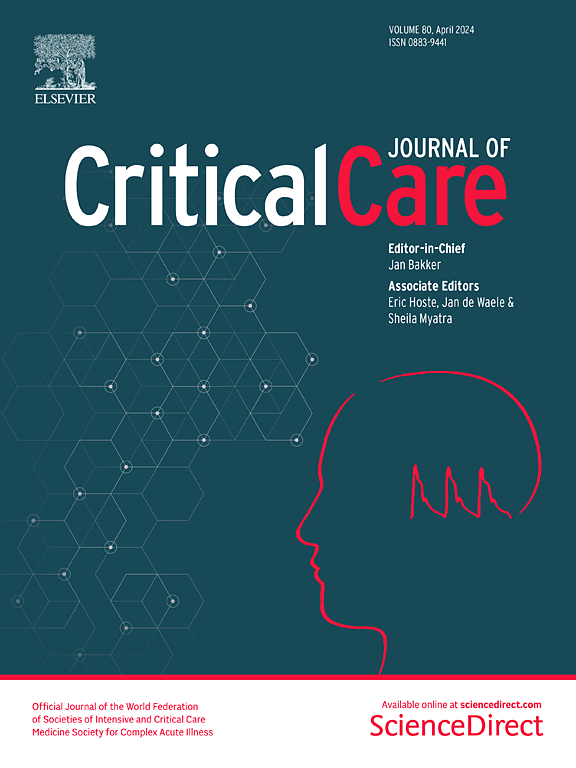不同 VV ECMO 血流速度对基于高渗盐水栓剂的电阻抗断层扫描肺灌注评估的影响
IF 8.8
1区 医学
Q1 CRITICAL CARE MEDICINE
引用次数: 0
摘要
我们的研究旨在探讨不同的体外膜肺氧合(ECMO)血流速度对静脉-静脉(VV)ECMO 患者使用生理盐水栓基电阻抗断层扫描(EIT)技术进行肺灌注评估的影响。在这项单中心前瞻性生理学研究中,符合 ECMO 断流标准的 VV ECMO 患者在不同的 ECMO 血流速度下(从 4.5 升/分钟逐渐降至 3.5 升/分钟、2.5 升/分钟、1.5 升/分钟,最后降至 0 升/分钟)使用生理盐水栓基 EIT 评估肺灌注。比较了不同流速下的肺灌注分布、死腔、分流、通气/灌注匹配和再循环分数。共纳入 15 名患者。随着 ECMO 血流速度从 4.5 升/分钟降至 0 升/分钟,再循环分数显著下降。基于 EIT 的主要研究结果如下。(1) 中位肺灌注量在感兴趣区(ROI)2 和腹侧区域明显增加[分别为 38.21 (34.93-42.16)% 至 41.29 (35.32-43.75)%,p = 0.003 和 48.86 (45.53-58.96)% 至 54.12 (45.07-61.16)%,p = 0.分别为 7.87 (5.42-9.78)% 至 6.08 (5.27-9.34)%,p = 0.049,以及 51.14 (41.04-54.47)% 至 45.88 (38.84-54.93)%,p = 0.037],而在 ROI 4 和背侧区域则显著下降。(2)腹腔和全腔死腔明显减少,通气/灌注匹配明显增加。(3)区域和全局分流无明显变化。在 VV ECMO 期间,ECMO 血流速度与再循环分数密切相关,可能会影响使用高渗盐水栓剂 EIT 评估肺灌注的准确性。本文章由计算机程序翻译,如有差异,请以英文原文为准。
Effects of different VV ECMO blood flow rates on lung perfusion assessment by hypertonic saline bolus-based electrical impedance tomography
Our study aimed to investigate the effects of different extracorporeal membrane oxygenation (ECMO) blood flow rates on lung perfusion assessment using the saline bolus-based electrical impedance tomography (EIT) technique in patients on veno-venous (VV) ECMO. In this single-centered prospective physiological study, patients on VV ECMO who met the ECMO weaning criteria were assessed for lung perfusion using saline bolus-based EIT at various ECMO blood flow rates (gradually decreased from 4.5 L/min to 3.5 L/min, 2.5 L/min, 1.5 L/min, and finally to 0 L/min). Lung perfusion distribution, dead space, shunt, ventilation/perfusion matching, and recirculation fraction at different flow rates were compared. Fifteen patients were included. As the ECMO blood flow rate decreased from 4.5 L/min to 0 L/min, the recirculation fraction decreased significantly. The main EIT-based findings were as follows. (1) Median lung perfusion significantly increased in region-of-interest (ROI) 2 and the ventral region [38.21 (34.93–42.16)% to 41.29 (35.32–43.75)%, p = 0.003, and 48.86 (45.53–58.96)% to 54.12 (45.07–61.16)%, p = 0.037, respectively], whereas it significantly decreased in ROI 4 and the dorsal region [7.87 (5.42–9.78)% to 6.08 (5.27–9.34)%, p = 0.049, and 51.14 (41.04–54.47)% to 45.88 (38.84–54.93)%, p = 0.037, respectively]. (2) Dead space significantly decreased, and ventilation/perfusion matching significantly increased in both the ventral and global regions. (3) No significant variations were observed in regional and global shunt. During VV ECMO, the ECMO blood flow rate, closely linked to recirculation fraction, could affect the accuracy of lung perfusion assessment using hypertonic saline bolus-based EIT.
求助全文
通过发布文献求助,成功后即可免费获取论文全文。
去求助
来源期刊

Critical Care
医学-危重病医学
CiteScore
20.60
自引率
3.30%
发文量
348
审稿时长
1.5 months
期刊介绍:
Critical Care is an esteemed international medical journal that undergoes a rigorous peer-review process to maintain its high quality standards. Its primary objective is to enhance the healthcare services offered to critically ill patients. To achieve this, the journal focuses on gathering, exchanging, disseminating, and endorsing evidence-based information that is highly relevant to intensivists. By doing so, Critical Care seeks to provide a thorough and inclusive examination of the intensive care field.
 求助内容:
求助内容: 应助结果提醒方式:
应助结果提醒方式:


